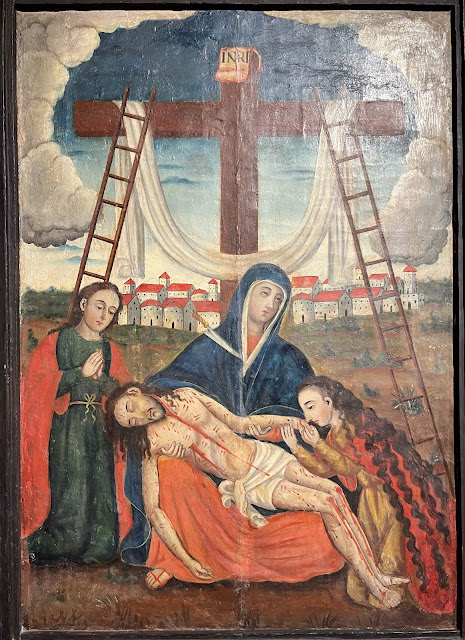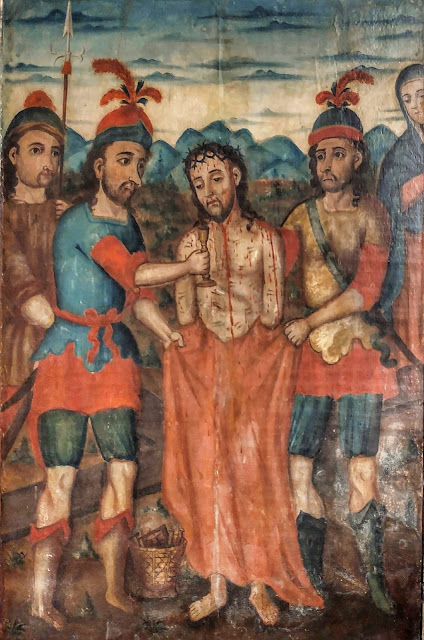 |
| XIII Jesus is taken down from the Cross |
Starting in the 15th and 16th centuries, the Franciscans created the first models of the Via Crucis (Way of the Cross) or Stations of the Cross to bring the Jerusalem experience closer to the faithful. Pope Innocent XI in 1686, granted the Franciscan Order the right to build the Via Crucis inside churches. Christians, primarily Catholics, would pray at each station of the cross either during Maundy Thursday or Good Friday.
When I was younger, I used to spend my Holy Week vacation in Albay. I remember how during Maundy Thursday, we would do our own version of Visita Iglesia and make it a point to pray at the Stations of the Cross. Some churches would have paintings depicting the last hours of Christ or another variation would be sculpted woodwork.
I regret that when I visited six Laguna churches in 2018, I wasn't focused on taking notes or photos of the Via Crucis surrounding the church nave. I was too busy admiring the overall architecture and structure of the building and not the treasures in it. The Franciscans built most, if not all, of the heritage churches in Laguna. It would have been a great thing to learn if any of these churches are keeping centuries-old stations of the cross. In most books that I've read about Philippine Churches, there was minimal mention of the Via Crucis.
 |
| The author at Gallery II Exhibit of the Via Crucis by An Unknown Bohol Master |
In the past five years, I've visited the National Museum of Fine Arts thrice, and each time I made it a point to stroll inside Gallery II which holds 14 paintings on wood panels of the Via Crucis by an unknown Bohol Master. Described as part of the 100 Treasures of Philippine Art from the collection of the Bangko Sentral ng Pilipinas. The provenance of the wood panels dates back to 1830 as inscribed on some of the paintings. This set of the Via Crucis must be one of the oldest in the country. And it even looks like the paintings are still mounted on their original wooden frames. Some historians have attributed the artworks as made by an artist of the Bohol School of Painting. This term is used to reference Boholano artisans and artists during the Spanish Colonial Period.
 |
| Inscription on one of the paintings: Ano del Senor de 1830 |
Another clue that ties the paintings to Bohol is the depiction of the mountain range in the background. Panels 2, 3, 9, 10, 11, and 14 show the "Bohol landscape of conical limestone hills" which we now refer to as Chocolate hills. The personages in the paintings appear to have European features which are the usual imagery of that time. I surmise that the Bohol master could have based his own portrayal on copies owned by the friars or priests that came from Europe.
It remains a mystery where this set of Via Crucis came from. Numerous church treasures of Bohol were sold to antique/art dealers and collectors, especially in the 1970s and 1980s. These were legalized transactions and were allowed by church officials. Church historian and author, Regalado Trota Jose wrote in his Foreword for the book, "Pagsulay: Churches of Bohol Before and After the 2013 Earthquake, that there was a "hemorrhage of art pieces". He also shared that one art dealer once told him there was "nothing else to steal".
One well-known Filipino collector donated his collection of church treasures to the San Agustin Museum in Intramuros. These 14 paintings of the Stations of the Cross were acquired by the Bangko Sentral ng Pilipinas and are on permanent loan to the National Museum of the Philippines Fine Arts.
These scenes of the passion and death of Jesus Christ are truly worth a visit to the National Museum whether you're there for the art or for a state of peace and quiet.
Via Crucis by An Unknown Bohol Master. Oil on Wood Panel. 1830
 |
| I Jesus is condemned to death |
 |
| II Jesus takes up his Cross |
 |
| III Jesus falls for the first time |
 |
| IV Jesus meets his Mother |
 |
V Simon of Cyrene helps Jesus carry the Cross VI Veronica wipes the face of Jesus |
 |
| VII Jesus falls for the second time |
 |
| VIII Jesus meets the women of Jerusalem |
 |
| IX Jesus falls for the third time |
 |
| X Jesus is stripped of his garments |
 |
| XI Jesus is nailed to the Cross |
 |
| XII Jesus dies on the Cross |
 |
| XIII Jesus is taken down from the Cross |
 |
| XIV Jesus is laid in the tomb |
We adore Thee, O Christ, and we praise Thee.
Because by Thy holy Cross, Thou hast redeemed the world.
References:
Pagsulay: Churches of Bohol Before and After the 2013 Earthquake. J. Eleazar R. Bersales. University of San Carlos Press. 2014
Kapuso Mo, Jessica Soho: OBRANG VIA CRUCIS NA NAKA-DISPLAY SA NATIONAL MUSEUM, SINO ANG NAGPINTA? Aired November 21, 2021 via YouTube.
https://www.nationalmuseum.gov.ph/author/nationalmuseumgmail-com/
Gallery of the Via Crucis of An Unknown Bohol Master, National Museum Fine Arts
Links to Additional Readings:
Six Franciscan Heritage Churches in Laguna
The Campana de Vuelo of Sta. Teresa de Avila Parish
Why Are Chinese Lions Guarding Philippine Catholic Churches?
A Heritage Visit to San Miguel Arcangel Church in Argao
La Campana de Santo Niño del Zebu
Comments